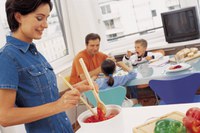Prairie Fare: Common Kitchen Practices Aren’t Always Safe
(Click the image below to view a high-resolution image that can be downloaded)
By Julie Garden-Robinson, Food and Nutrition Specialist
NDSU Extension Service
I recall being at the home of a close relative a few years ago. The person shall remain anonymous to preserve peace in the family. You probably know how that goes.
When I went to get a drink of water, I noted ground beef thawing in the sink. Of course, I couldn’t let the opportunity for food safety education pass. Actually, we share a lifetime of mostly good-natured needling of each other, so I got to play the role of obnoxious food safety specialist.
“Did someone forget to put the meat in the refrigerator?” I asked with just a bit of sarcasm.
“It’s only been out a few hours,” was the reply, with a bit of disdain.
“Are we having bacterial toxin for dinner?” I needled.
“You’re not invited for dinner,” was the reply. That quieted me down.
I took the matter into my own hands by putting the meat in a pan and placing it in the refrigerator. Fortunately, no quarrel or combat ensued.
Many common practices in kitchens, such as thawing on the counter, aren’t necessarily safe ones. Food can be thawed safely in the refrigerator, in the microwave followed by immediate cooking, under cool water (in the case of poultry) and as part of the cooking process.
Improperly thawing food on the counter can lead to the formation of toxins that might not be killed during later cooking. These toxins can lead to flulike symptoms, which can be severe among vulnerable groups such as children, the elderly, immune-compromised and pregnant women.
Kitchens can be hazardous places, so it’s good to be informed about the latest research. Consider these questions and responses based on food safety research:
- Have you ever used plastic trash bags for food storage? Trash bags are not food-grade plastic and should not be used to store food. Often they are treated with pesticides, which can be harmful.
- Do you reuse plastic bottles that held purchased water (such as spring water)? The water bottles are not meant for multiple uses and may not withstand the water temperatures needed for proper cleaning.
- Do you use Styrofoam containers from restaurants or margarine tubs to reheat leftovers in a microwave oven? This isn’t considered a safe practice because the container may melt and chemicals can migrate into the food during microwave heating.
- Have you ever used brown paper bags to cook turkey or other foods? This is not recommended because the bags are not food grade. The bags may ignite in the heat of the oven, and the ink or glue may emit toxic fumes.
- Have you ever used paint brushes as “pastry brushes” in the kitchen? Paint brushes are not meant for food use. Pastry brushes and other utensils can lead to cross contamination, so they need to be cleaned carefully.
- Do you use sponges to clean kitchen surfaces? Sponges can harbor millions of germs because they provide a moist, warm place for germs to thrive. Dishcloths are a better option because they can be laundered more easily. In fact, it’s a good idea to use a fresh dishcloth at least daily. Paper towels are another good option in the kitchen.
Here’s a simple recipe that kids like. Pair it with a spinach salad, sliced apples with fruit dip and low-fat or fat-free milk for a tasty meal. Follow these food safety tips: Thaw the meat in the fridge and reheat the leftovers in a microwave-safe container.
Easy Pasta Bake
1 pound extra-lean ground beef, browned
2 c. cooked pasta (such as vermicelli)
1 15-ounce jar spaghetti sauce (low-sodium)
1/3 c. Parmesan cheese
1 c. part-skim mozzarella cheese
Preheat the oven to 350 degrees. Brown ground beef. Cook pasta according to package directions. Mix together browned ground beef, pasta, spaghetti sauce and Parmesan cheese, top with mozzarella cheese and place in a greased or sprayed 9- by 13-inch baking dish. Cover pan with foil. Bake at 350 degrees for 15 minutes. Uncover and bake for another 10 minutes, until internal temperature reaches at least 165 degrees.
Makes six servings. Each serving has 340 calories, 13 grams (g) of fat, 21 g of carbohydrate, 2 g of fiber and 280 milligrams of sodium.
(Julie Garden-Robinson, Ph.D., R.D., L.R.D., is a North Dakota State University Extension Service food and nutrition specialist and professor in the Department of Health, Nutrition and Exercise Sciences.)
NDSU Agriculture Communication – Sept. 11, 2014
| Source: | Julie Garden-Robinson, (701) 231-7187, julie.garden-robinson@ndsu.edu |
|---|---|
| Editor: | Rich Mattern, (701) 231-6136, richard.mattern@ndsu.edu |


